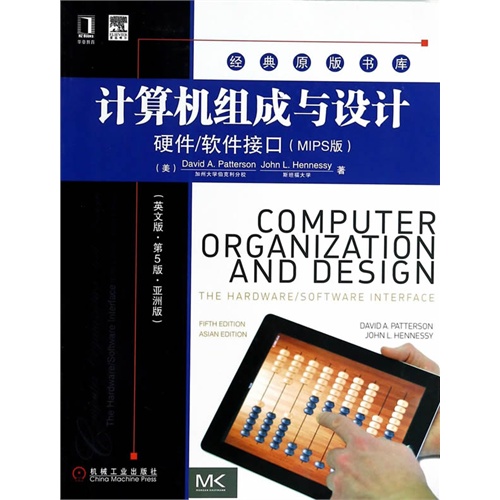
计算机组成与设计-硬件/软件接口-(第5版)-(MIPS版)-(英文版.亚洲版)

- ISBN:9787111453161
- 装帧:一般胶版纸
- 册数:暂无
- 重量:暂无
- 开本:其它
- 页数:563
- 出版时间:2014-02-01
- 条形码:9787111453161 ; 978-7-111-45316-1
本书特色
帕特森、亨尼斯所著的《计算机组成与设计(硬件软件接口MIPS版英文版第5版亚洲版)》包含新的实例、练习和资料,重点介绍新出现的移动计算和云计算。涵盖从串行计算到并行计算的革命性变革,特别用一章篇幅讲述并行处理器,并且每章中还有一些强调并行硬件和软件主题的小节。全书采用Intel Core i7、ARM Correx-A8和NVIDIA Fermi GPU作为实例。增加一个新的实例“Going Faster”,展示正确理解硬件技术能够激发软件优化,提高200倍的性能。 讨论并强调计算机体系结构的“八大理念”——Performance via Parallelism;Performance via Pipelirring;Performa rice via Prediction;Design for Moore's Law;Hierarchy of Memories;Absttraction to Simplify Design;Make the Common Case Fast;Dependability via Redundancy。 全面更新和改进了练习。
内容简介
帕特森、亨尼斯所著的《计算机组成与设计(硬件软件接口MIPS版英文版第5版亚洲版)》这本*畅销的计算机组成与设计的经典教材经过全面修订,关注后PCB寸代发生在计算机体系结构领域的革命性变革(从单处理器发展到多核微处理器。从串行发展到并行),并强调了新出现的移动计算和云计算。为了研讨和强调这种重大的变化,《计算机组成与设计(硬件软件接口MIPS版英文版第5版亚洲版)》更新了许多内容,重点介绍平板电脑、云体系结构以及ARM(移动计算设备)和x86(云计算)体系结构。因为正确理解现代硬件对于实现好的性能和能效至关重要,所以本版在全书中增加了一个新的实例“GoingFaster”,以演示非常有效的优化技术。本版还新增了一个关于计算机体系结构“八大理念”的讨论。与前几版一样,本书采用MIPS处理器来展示计算机硬件技术、汇编语言、计算机算术、流水线、存储器层次结构以及I/O等基本功能。
目录
-

写给小白的Python入门实战课
¥18.5¥50.0 -

Photoshop图像处理标准培训教程
¥23.8¥68.0 -

翻转世界-互联网思维与新技术如何改变未来
¥18.5¥49.9 -

Excel 实战应用大全
¥18.4¥49.8 -

Excel高效办公应用于技巧大全
¥21.4¥49.8 -

像数据达人一样思考和沟通:数据科学、统计学与机器学习极简入门
¥48.3¥68.0 -

造神:人工智能神话的起源和破除 (精装)
¥61.6¥88.0 -

全图解零基础word excel ppt 应用教程
¥16.8¥48.0 -

ABAQUS 6.14超级学习手册
¥78.5¥109.0 -

物联网关键技术及其数据处理研究
¥22.1¥59.8 -

Word/Excel/PPT高效商务办公从入门到精通
¥17.8¥48.0 -

多功能智能机器小车的开发与研制
¥20.7¥56.0 -

APP INVENTOR少儿趣味编程动手做
¥21.8¥59.0 -

Python数据爬取技术与实战手册
¥22.7¥59.8 -

HTML & CSS设计与构建网站
¥43.9¥79.8 -

机器学习导论
¥47.4¥79.0 -

flash经典课堂动画、游戏与多媒体制作案例教程
¥54.5¥99.0 -

四步创业法
¥27.4¥48.0 -

推荐系统:产品与算法解析
¥62.2¥79.8 -

你好!PYTHON
¥74.9¥99.9









